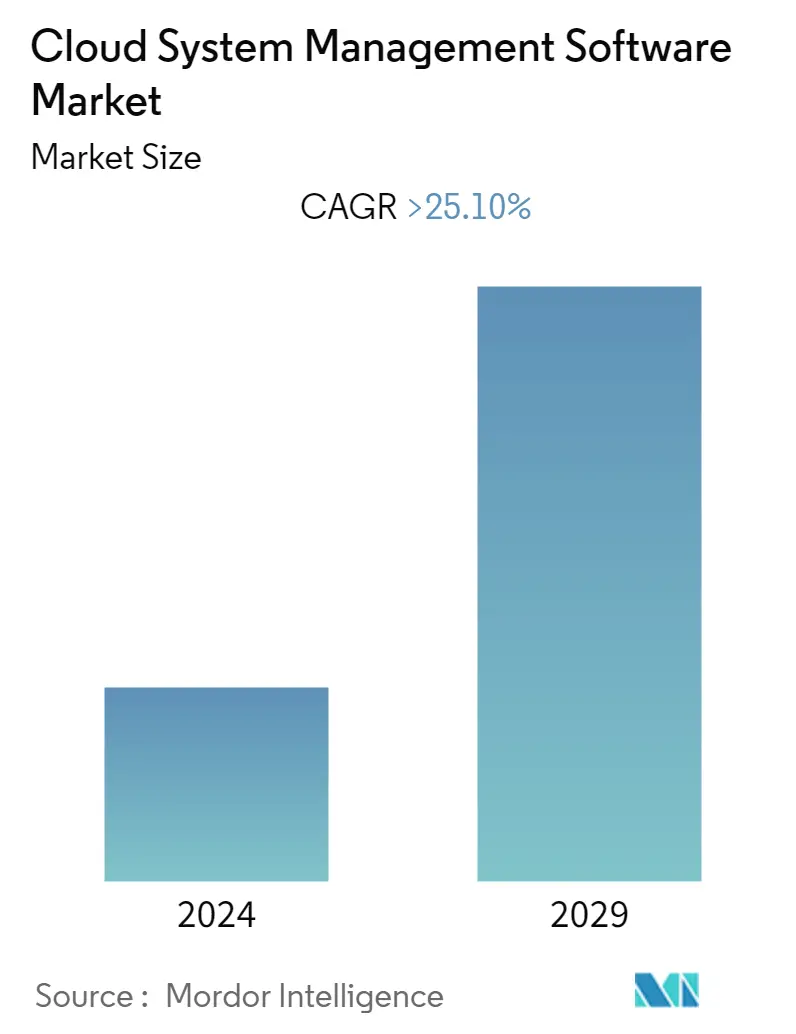Market Size of Cloud System Management Software Industry

| Study Period | 2019 - 2029 |
| Base Year For Estimation | 2023 |
| CAGR | > 25.10 % |
| Fastest Growing Market | Asia Pacific |
| Largest Market | North America |
| Market Concentration | Low |
Major Players
*Disclaimer: Major Players sorted in no particular order |
Need a report that reflects how COVID-19 has impacted this market and its growth?
Cloud System Management Software Market Analysis
The Cloud System Management Software Market is anticipated to witness a CAGR greater than 25.1% during the forecast period. With the growth of cloud solutions and services, cloud computing technology is quickly establishing itself as the norm. Businesses and organizations no longer need to spend as much money on their own physical IT infrastructure thanks to cloud computing. Companies are compelled to shift their apps and operations to the cloud for various reasons, including the potential for significant financial savings.
- Software used to administer a cloud system is referred to as cloud system management software. This framework helps to steer the cloud's automation and operations. With a stronger emphasis on digital transformation, AI, and big data analytics, many enterprises turned to cloud services. On the other side, corporations are spending more on cloud services as they implement multi-cloud strategies and move more workloads and data there.
- Demand for the cloud system management market is being driven by the rising popularity of hybrid and multi-cloud designs, which allow for consistent building and operation across cloud, on-premises, and edge environments. Initiatives for digital transformation and optimization have benefited greatly from the cloud. Companies invest in organized innovation programs to achieve business objectives, react to market circumstances, and implement expedited digital transformation projects. As an illustration, IBM created Red Hat OpenShift, the industry-recognized hybrid cloud container technology. Users can create and access cloud services from any cloud and from any location using Red Hat OpenShift.
- The requirement to manage and execute apps through a SaaS model or manage a cloud architecture with an IaaS or PaaS platform arose as cloud software became a staple of any business IT environment. Enterprises turned to deployments between private and public, multiple public, and numerous private and public clouds as soon as Infrastructure-as-a-Service (IaaS) was introduced. As a result, the adoption of cloud system management experienced a significant landscape shift in favor of performance, cost, configuration monitoring, and analytics. Similarly, companies in the industry under investigation used strategic alliances and acquisitions to broaden their portfolios.
- Two problems that arise with multi-cloud are vendor lock-in worries and a need for more cloud spend control. Vendor lock-in refers to a situation where the cost of switching vendors is so high that the customer is essentially stuck with the original vendor because of financial constraints, a lack of workforce, or the need to prevent business operations from being disrupted, which could impede the growth of cloud system management software. Also, there is a constant risk of data breaches, which impedes industry development.
- Businesses increasingly use enterprise solutions to employ cloud-based apps to target a niche market. This adoption brought about much more substantial changes in these organizations' priorities. In addition, as the need for digital technologies increases, cloud-based apps rather than on-premise ones are more frequently used to maintain consistent enterprise business operations. Because of rising cost-cutting initiatives and pressure to produce more from IT systems and software, COVID-19 had a considerable impact on the global market. The cloud software segments were consequently looking toward SaaS delivery models with proactive and predictive optimization capabilities, enhanced application performance, and robust cost control due to COVID-19.
